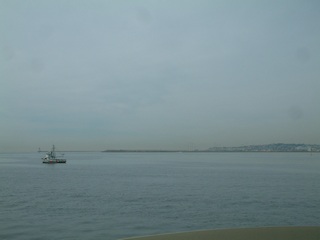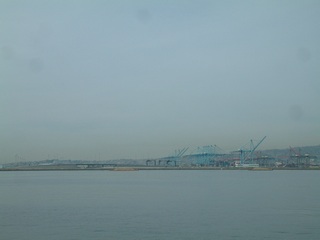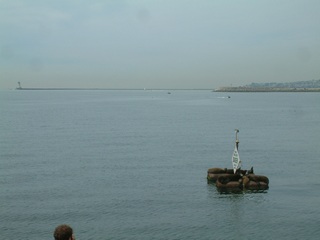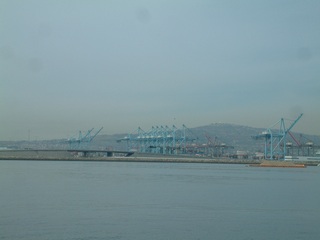There is also an old Edison power
generating station
which
has dikes around it to prevent flooding. During peak power
consumption
periods, this power plant is restarted. Oil production in the
late
1800's and early 1900's allowed the land to sink 29 feet. Water
was
injected into the oil field to prevent further subsidence. This
point
of land is also the original Long Beach Harbor entrance. All land
from
here to the harbor entrances is reclaimed. Opposite of the power
station is a City of Long Beach Fire Station with the firefighting boat
Liberty at the dock.
South of the Desmond Bridge are more
bulk
marine
terminals handling more scrap metal, cement and petroleum
products.
The bulk oil ship "Tonsina" is most likely from Alaska. Captain
Wilson
explained the tugboat at the stern of the "MSC Atlantic" ship is used
for steering purposes.
The bulbous nose of the "OOCL Ningbo"
helps
increase cruising speed of the large ships.
The harbor now opens
up
with the former Naval Station Long Beach in view to the west.
While
still a Naval Station, it was my sailing playground when my father had
his small Catalina 22 sailboat. The property has been redeveloped
into
more marine shipping terninals.
The large ships in view are Sea
Launch, an international consortium of Boeing, the Russians and
Norwegians which specializes in launching 9 space vehicles annually
from a ship mounted pad on the ocean.
The Naval Mole, a
breakwater,
now has railroad track on it. In 2002, Union Pacific took a train
to
the Port of Long Beach for a convention group to visit the Sea Launch
berth. Pier F has the Long Beach Pilot dock, from which harbor
pilots
guide large ships from the harbor entrance to berth. Ship
captains
must speak English to communicate with the harbor pilots. In the
Naval
Station sailing days, we could always smell barbeque smoke enanating
from the end of the Naval Mole. It is now a bird sanctuary.




Outside
the Naval Mole the Maersk Pier 400 shipping complex is visible.
At
this point, Captain Wilson gave some history of the harbor. In
1542
Cabrillo "found" Long Beach Harbor. In 1899 construction of the
breakwater began. Rock was quarried and imported from Riverside,
about
45 miles distant. In later years, rock was taken from the 74
square
mile Catalina Island, some 25 miles away. Rock could be chipped
off
the island and dumped directly onto barges, then towed to the
breakwater construction site. The joke here is that the port gets
bigger and the island gets smaller. The harbors have a minimum
depth
of 45 feet and maximum depth of 80 feet.
The harbor is home to wildlife such
as
California Sea Lion which has the distinction of being able to push its
body up using its front flippes and can propel itself forward using its
back flippers. The harbor sealspictured below, cannot do this.
There are 3 entrances to
the
LA/LB harbors. The Angel's Gate leads into the Los Angeles San
Pedro
harbor side and the Queen's Gate leads into the Long Beach side while
the southerly entrance is at the Los Angeles /Orange County
line.
Angel's Gate lighthouse has the distinction of having a green light to
avoid confusion with the 2 other local lighthouses. The only
other
Pacific ocean lighhouse shining a green light is in Tokoyo Japan.
Page 5 APTA Alameda Corridor & Harbor
Cruise